The beauty of hockey is that the season is never truly over. Just a week separated from their Game 7 loss in the Stanley Cup Final, the Boston Bruins found themselves at the 2019 NHL Draft in Vancouver, British Columbia.
After a successful draft, reeling in prospects like John Beecher, Quinn Olson, and Roman Bychkov, the B’s are faced with their next task of the summer: free agency.
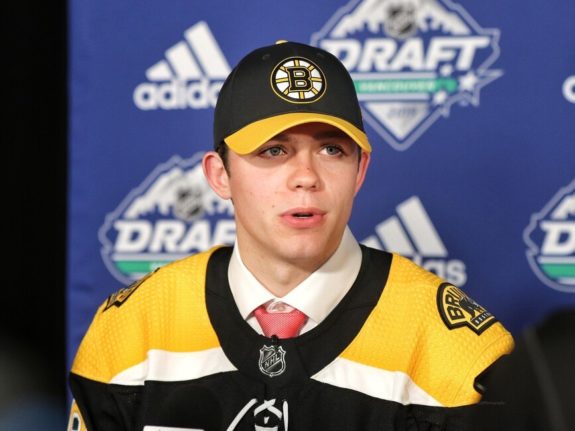
On their list of restricted free agents (RFA) are Charlie McAvoy, Brandon Carlo, Danton Heinen, Jakob Forsbacka Karlsson, Ryan Fitzgerald, Gemel Smith, and Peter Cehlarik. This is in addition to a slew of unrestricted free agents (UFA) which includes Marcus Johansson, Noel Acciari, Steven Kampfer, Zane McIntyre, Lee Stempniak, Jordan Szwarz, and Mark McNeill.
While that looks to be a long list, it’s safe to say that at least half of these pending free agents will be moving on from Boston. The salary cap has only been bumped up to $81.5 million for the 2019-20 season after it was expected to rise to as much as $83 million prior to this weekend’s announcement. This means that the Bruins have roughly $12.8 million in cap space to work with.
Boston’s main focus will be keeping McAvoy and Carlo, both of whom will soak up the vast majority of that space – potentially all of it. Though he only appeared in 54 games this season, McAvoy tallied 28 points as a 21-year-old. He will likely be seeking a long-term deal and, considering what a number of young players have been going for the past two seasons, the defenseman is due for a big payday. He will almost certainly be looking for something north of $6 million and it wouldn’t be surprising if he went for far more.
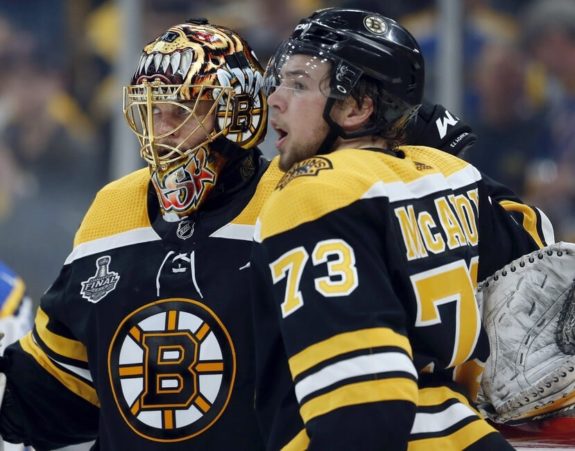
Carlo will be relatively cheaper considering he has been playing on Boston’s second defensive pair for much of his young career. Though his 10-point 2018-19 season is certainly a lowlight, the 22-year-old has been one of the Bruins’ best blueliners given his play within his own zone. He will also be seeking a long-term deal with decent pay – likely somewhere in the $4 million range.
Unfortunately for Boston, that’s just the start. Corralling Forsbacka Karlsson, Fitzgerald, and Cehlarik is also a necessity to keep the team’s prospect pool intact. These centers are in line to replace the ageing Patrice Bergeron and David Krejci and perhaps one could nail down a spot as a winger next season.
While it isn’t a necessity, the Bruins are looking to keep Acciari for a low price. If they can’t, the B’s have plenty of options when it comes to filling out the fourth line with Sean Kuraly, Joakim Nordstrom, and Chris Wagner still under contract. Holding on to Marcus Johansson is something of a dream for those in Boston. The forward can easily rake in $4 million on the open market and could spark a number of suitors. If the Bruins are too keep him on the roster, they will also need to pay.
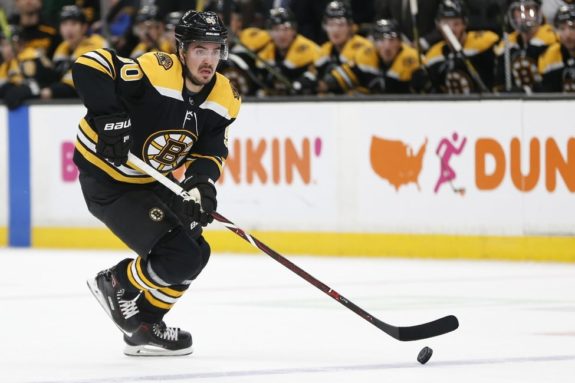
In order to get all – or even just some – of this done, the B’s will need to create some cap space. Doing so is always tricky, whether it is convincing a team to take on an underperforming player or deciding to part ways with a star. There are many ways the Bruins could go about making room for their free agents, here are just a handful.
1. Torey Krug
Role: Top-4 D, Power Play
Cap Hit: $5.25 million
Length: 1 year
Torey Krug has made a huge impact since being signed by Boston back in 2012. What was originally a $900,000 cap hit slowly grew to $1.4 million, $3.4 million, and currently $5.25 million annually. This four-year deal signed in 2016 will come to end next summer.
Trade rumors have been swirling around Krug throughout the season. He has become the Bruins’ most expensive defenseman since Zdeno Chara’s year-by-year contracts have slowly gone down in value – the captain will be making just $2 million during the 2019-20 season. Krug’s modified no-trade clause (NTC) isn’t too hard to work around: he is allowed to submit a list of just eight teams that he cannot be traded to, leaving 23 squads still on the table.
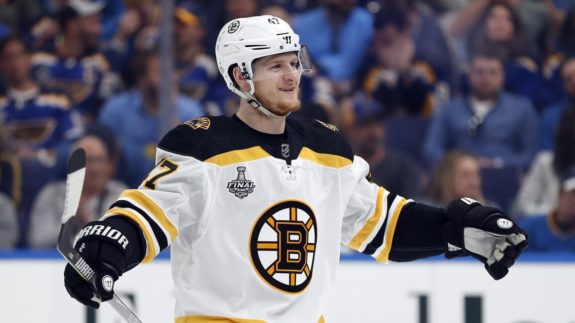
In making this tough decision, it’s important to consider how losing Krug would affect the Bruins. For starters, their power play would take a huge blow. In 64 games this season, 30 of the blueliner’s 53 points came with the man advantage. He has been Boston’s first-string power play quarterback for some time and his playmaking abilities would certainly be missed.
When it comes to five-on-five play, Krug’s defense has been average at best. There have been numerous occasions where the 28-year-old has let down his team in this regard and it is the biggest reason onlookers have called for him to be shipped off. It seems as though he needs a stay-at-home defensive partner to keep him afloat.
Fortunately for Krug, that’s exactly what he’s had. Carlo is just his most recent partner that has taken on the majority of the workload behind the blue line. This has freed up Krug to do what he does best: create defense-to-offense transitions, get pucks on net, and set up his teammates.
General manager Don Sweeney has stated that “it would take a pretty unique opportunity” for the team to move on from the Michigan native. He is someone the Bruins rely on heavily and his presence on the ice and in the dressing room would be sorely missed:
Trading Krug is certainly an option. However, it seems to be the most unlikely scenario listed in this article. The defenseman will cost a pretty penny when it is time to re-sign him next year, but it seems as though management is keen on keeping him.
2. David Krejci
Role: Top-6 F, Power Play
Cap Hit: $7.25 million
Length: 2 years
Many in Boston have been calling for a Krejci trade for some time. A forward who was considered to be the team’s first-line center when signing his most recent contract has since dropped down to the second line. He has remained the Bruins’ most expensive player despite having stars like Bergeron, Brad Marchand, and David Pastrnak on the roster.
However, Krejci has played a huge role in the B’s success this decade. He helped the team to a Stanley Cup title in 2011 and has continued to propel them into the playoffs season after season. When it comes to the postseason, the centerman has been able to come up clutch – at least when he hasn’t been hindered by injuries.
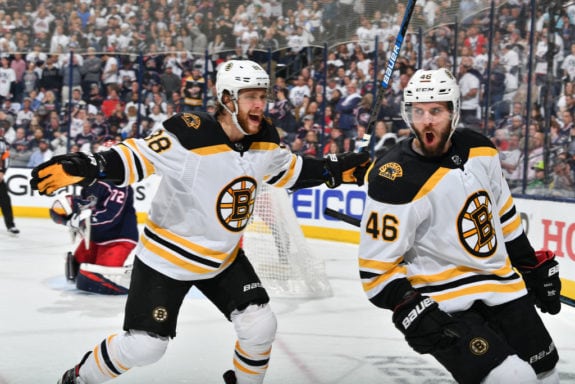
Another cause for fans wanting Krejci gone is just that – during his time in Boston, he has been one of the club’s most injury-prone players. However, this season he appeared in all but one contest and played in all 24 of the team’s playoff games. When he sinks, so do the Bruins, but when he’s performing at his best the team often does as well.
The Czech native tallied 73 points during the 2018-19 season, tying his career high total put up in the 2008-09 season when he was just 22 years old. It’s a huge boost since his last full season played in 2016-17 when he cumulated just 54 points.
While this most recent performance makes it hard to pull the trigger, it also makes Krejci more tradable. He does have an NTC that allows him to exempt half the league from pursuing him, but tying his career high in points at the age of 33 would likely earn him plenty of suitors. His cap hit is certainly weighing down on the Bruins, but for a team in the hunt with money to spend, the prolific center could be a great fit.
When it comes to trading away one of Boston’s biggest contracts, Krejci is one of the biggest candidates. However, the B’s have taken on a win-now mentality which indicates that Krejci will likely remain a Bruin next season.
3. David Backes
Role: Bottom-6 F
Cap Hit: $6 million
Length: 2 years
The Bruins signed Backes to a five-year deal worth $6 million annually on the first day of free agency in 2016. It was a gamble that the team certainly regrets.
Though the 35-year-old had a strong showing at the dawn of his NHL career, he only tallied 45 points in his last season with the St. Louis Blues before signing the hefty deal with Boston. He tallied 38 points in 77 games during his first campaign with the Bruins. That decreased to just 20 points in 70 appearances this past season.
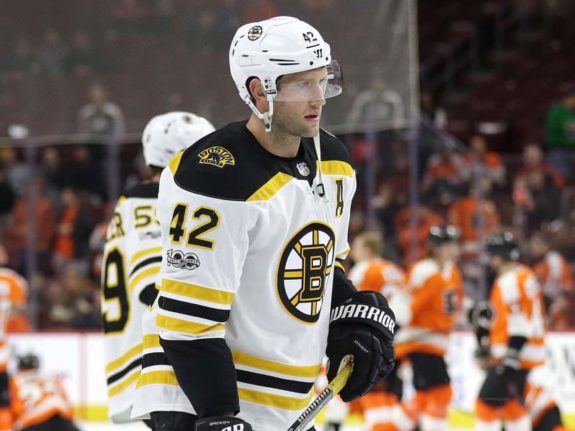
Backes would be a tough sell when it comes to trade talks – he certainly hasn’t earned his $6 million cap hit throughout his time in a black and gold sweater. The most feasible way to get the veteran off the payroll would be via a buyout, but even that doesn’t solve Boston’s salary cap situation.
If the Bruins were to buyout Backes this summer, he would still hit the cap for $5.66 million during the 2019-20 season, saving them less than $350,000. He would then hit the cap for $3.66 million during the 2020-21 campaign before dwindling to less than $675,000 for each of the following two seasons.
Buying out the Minnesota native would still help Boston’s cap situation in the long run which makes it something worth considering. However, it does little to aid them in re-signing McAvoy, Carlo, and others this offseason.
Honorable Mentions: Heinen, Miller
While the Bruins would only make modest gains with these moves, trading away Danton Heinen or Kevan Miller – or even both – would create some room to work with.
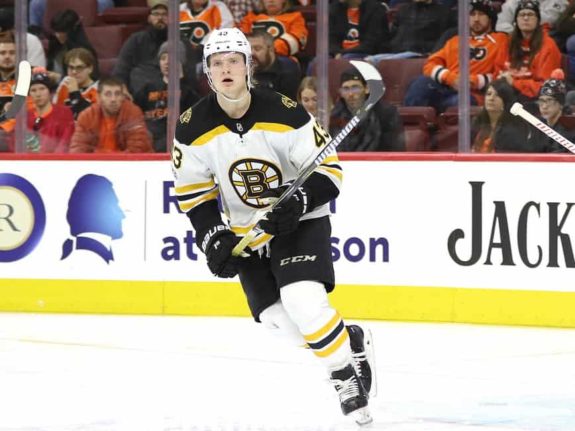
Heinen has played with nearly every forward Boston skated this season but, due to his struggles, he seems to have only found a stable home on the third line. The forward, who will turn 24 in a matter of weeks, will become an RFA this summer, which would mean trading his rights to another team. This past season, the British Columbian managed 11 goals and 23 helpers in 77 games. While those totals aren’t awful, they are still expendable.
There will be little room to re-sign Heinen this summer, assuming the Bruins hold onto McAvoy and Carlo (and possibly others) – especially with Krug, Jake DeBrusk, Charlie Coyle, Matt Grzelcyk, Connor Clifton, and Kevan Miller all requiring renewals in 2020.
Speaking of Miller, he is expendable himself. The 31-year-old was plagued by injuries throughout the 2018-19 campaign causing him to skate in just 39 games. He missed the entirety of Boston’s Stanley Cup run this postseason. The stay-at-home defenseman has played a role on the penalty kill and in a physical manner, but it is clear that the Bruins managed just fine without him this past season.
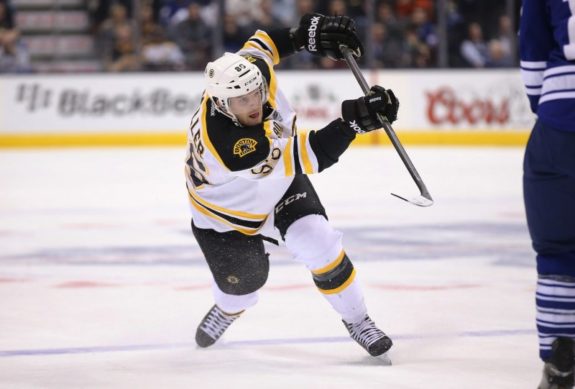
As a 24-year-old, Clifton brought a similar style of game to the ice while also providing an offensive upside. He will be looking to carve out a role in the starting lineup this fall and could fill Miller’s shoes if he is to be moved.
Miller currently hits the Bruins’ cap for $2.5 million – money that could be put to use in other areas. He is capable of holding onto a job on many of the NHL’s 31 bottom defensive pairs, meaning that Boston could get a decent return – even if it just a single prospect or a mid-tier draft pick.
The Bruins have their work cut out for them this offseason. They do have the roster required to make another run at the Cup next season. However, if they want to remain contenders beyond the 2019-2020 campaign, some transactions are required.